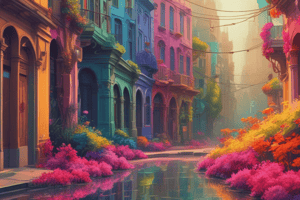Podcast
Questions and Answers
What is the purpose of the colour wheel in colour theory?
What is the purpose of the colour wheel in colour theory?
To show how colours relate to each other
What does the hue of a colour refer to?
What does the hue of a colour refer to?
The actual colour (e.g. red, blue, green)
What is the difference between the RGB and CMYK colour models?
What is the difference between the RGB and CMYK colour models?
RGB is additive and used for digital screens, while CMYK is subtractive and used for printing
What is the principle of colour harmony that involves using colours with a similar hue?
What is the principle of colour harmony that involves using colours with a similar hue?
What is a monochromatic colour scheme?
What is a monochromatic colour scheme?
What is the purpose of the triadic principle of colour harmony?
What is the purpose of the triadic principle of colour harmony?
Flashcards
What is the color wheel?
What is the color wheel?
A circular representation of colors, showing how they relate to each other. It includes primary, secondary, tertiary, warm, and cool colors.
What is Hue?
What is Hue?
The actual color (e.g., red, blue, green). It is measured in degrees, with 0°-360° representing the full color wheel.
What is Saturation?
What is Saturation?
The purity or intensity of a color. Ranges from 0% (gray) to 100% (fully saturated).
What is Value?
What is Value?
Signup and view all the flashcards
What is RGB?
What is RGB?
Signup and view all the flashcards
What is CMYK?
What is CMYK?
Signup and view all the flashcards
Study Notes
Colour Theory
The Colour Wheel
- A circular representation of colours, showing how they relate to each other
- Divided into primary colours, secondary colours, tertiary colours, warm colours, and cool colours
Colour Properties
Hue
- The actual colour (e.g. red, blue, green)
- Measured in degrees, with 0°-360° representing the colour wheel
Saturation
- The purity or intensity of a colour
- Ranges from 0% (grey) to 100% (fully saturated)
Value
- The lightness or darkness of a colour
- Ranges from 0% (black) to 100% (white)
Colour Models
RGB (Red, Green, Blue)
- Additive colour model used for digital screens
- Combines red, green, and blue light to create colours
CMYK (Cyan, Magenta, Yellow, Black)
- Subtractive colour model used for printing
- Combines cyan, magenta, and yellow inks to create colours, with black added for deeper shades
Colour Harmony
Principles of Colour Harmony
- Similarity: using similar colours
- Contrast: using contrasting colours
- Analogy: using colours with a similar hue
- Triadic: using colours equally spaced on the colour wheel
Colour Schemes
- Monochromatic: using different shades of the same colour
- Complementary: using colours opposite each other on the colour wheel
- Analogous: using colours next to each other on the colour wheel
Colour Theory
- The colour wheel is a circular representation of colours, showing how they relate to each other.
- It is divided into primary colours, secondary colours, tertiary colours, warm colours, and cool colours.
Colour Properties
Hue
- Hue refers to the actual colour (e.g. red, blue, green).
- It is measured in degrees, with 0°-360° representing the colour wheel.
Saturation
- Saturation refers to the purity or intensity of a colour.
- It ranges from 0% (grey) to 100% (fully saturated).
Value
- Value refers to the lightness or darkness of a colour.
- It ranges from 0% (black) to 100% (white).
Colour Models
RGB (Red, Green, Blue)
- RGB is an additive colour model used for digital screens.
- It combines red, green, and blue light to create colours.
CMYK (Cyan, Magenta, Yellow, Black)
- CMYK is a subtractive colour model used for printing.
- It combines cyan, magenta, and yellow inks to create colours, with black added for deeper shades.
Colour Harmony
Principles of Colour Harmony
- Similarity involves using similar colours.
- Contrast involves using contrasting colours.
- Analogy involves using colours with a similar hue.
- Triadic involves using colours equally spaced on the colour wheel.
Colour Schemes
- Monochromatic involves using different shades of the same colour.
- Complementary involves using colours opposite each other on the colour wheel.
- Analogous involves using colours next to each other on the colour wheel.
Studying That Suits You
Use AI to generate personalized quizzes and flashcards to suit your learning preferences.




